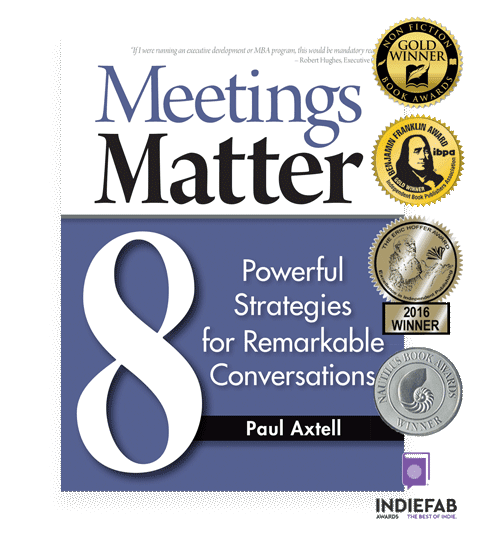A group of researchers at Google completed an intensive two-year study of more than 180 teams looking for the key characteristics of their high-performing teams. The New York Times article on the study is worth your time.
Two elements stood out:
1. Psychological safety—people felt safe to talk.
2. Broad participation—all team members have equal opportunity to contribute to the group conversation.
There was nothing Google did in advance to help create the high-performing teams. The researchers were simply curious to see if they could discover the distinguishing factors that might be able to guide other teams to better performance.
Let’s explore the notion of psychological safety. What allows people to be self-expressed in groups?
This is a broad question, and there are many possible factors. Therefore, it’s always good to put the question to your own group and find out what they need in order to feel it’s safe to say or ask anything.
Asking the question is the beginning of your group’s exploration, which is the most direct approach, but I’ll offer my top candidates for increasing the psychological safety in your group:
• Take the time to get to know each other.
• Make listening and attentiveness the norm.
• Don’t make negative comments—be less judgmental.
• Work to understand defensive tendencies—taking things personally.
Take the time to get to know each other—don’t wait for team building.
To get the real power out of your team meetings, it’s imperative to get to know each other in a way that gives you permission to say or ask anything—in a way that makes challenging, back-and-forth conversation accessible. It may seem as if you know each other, but you probably don’t—at least not in terms of what is possible.
You can deepen your relationships without waiting for special team-building events. Working on relationships requires deciding to make time for it. It’s simple, but not easy. It means making a commitment, then shifting priorities to allow the time for making connections. You are busy—perhaps busier than you would like to be. Still, part of working in an organization demands that you find time to create and maintain the relationships you need to be successful.
As Tom Scheuermann at Oregon State University puts it, “It’s either pay now or pay later. If we ‘pay’ with spending a little time building relationships, we will avoid ‘paying’ later with having to re-explain things, deal with bruised egos, or handle confusion or colleagues who don’t seem to care enough to deliver on time.”
In the face of this reality, make spending time with your colleagues a priority. Making this small adjustment in your priorities can involve only a couple of hours a month, yet still make a real difference. The benefits of deeper relationships, while perhaps not immediately apparent, will allow for more effective communication and reciprocal support.
In meetings, you can put this perspective into action when you:
• acknowledge people when they enter the room.
• check in with people a few minutes before and after the meeting.
• give people your complete attention when they speak during the meeting.
• acknowledge when someone’s comments add to your thinking.
• speak respectfully when you disagree.
• notice who hasn’t spoken yet and invite them into the conversation.
Make attention and listening the norm in your meetings.
Consider that there is a way of listening that allows people to speak authentically. A wonderful book by Michael Nichols, TheLost Art of Listening, makes the point that people typically listen to comprehend or to follow along in a conversation rather than to participate nonverbally in a way that lets the person speaking know you “got” what they said.
Nichols says that just listening without adding to or changing the conversation is what is important. Reassuring someone isn’t listening. Trying to solve the problem isn’t listening. Just listening is listening. And when people feel we are interested and paying attention, they will speak about the things that matter to them.
Yet we don’t listen very often, at least not in a way that is magical. We interrupt. We finish other people’s sentences. We pretend to listen. Sometimes we don’t even pretend.
Attention and caring are tightly connected. If you pay attention to someone who is speaking in a meeting or you pay attention to your small kids when they want to talk, they will interpret that you care. On the other hand, if you engage in side conversations or multitask with other work while people speak, they will make up that you are not interested. This will erode the safety and permission that exists in the meeting.
Always remember that your attention is a gift.
Don’t make negative comments—be less judgmental.
This is a tough one because the human mind is wired to continually assess and make judgments. The mind is fast—very fast, but American psychologist Carl Rogers, in his book On Becoming a Person, noted how this capacity to assess and judge can interfere with true communication:
The major barrier to interpersonal communication lies in the very natural tendency to judge—to approve or disapprove of the statements of the other person . . . Our first reaction to most of the statements which we hear from people is an immediate evaluation, or judgment, rather than an understanding of it. When someone expresses some feeling or attitude or belief, our tendency is, almost immediately, to feel “that’s right,” or “that’s stupid,” “that’s reasonable,” “that’s incorrect.” Very rarely do we permit ourselves to understand precisely what the meaning of the statement is to him.
Given the hardwired nature of this tendency to assess and judge, it isn’t productive to try to stop doing it. Still, because it can get in the way of your ability to understand and support others, there are ways to keep this judgmental mechanism at bay:
• Be curious.
• Remind yourself that the other person’s views are as legitimate as yours.
• Give the person speaking the benefit of the doubt; assume positive intent.
• When negative thoughts do occur, notice them and then set them aside and intentionally refocus on listening for clarity, understanding, and value.
Understand defensive tendencies—taking things personally.
“If you’re a person, then it’s personal.”—Denzel Washington, The Preacher’s Wife
One of my mentors consistently reminded managers: “Everyone is a little bit scared and a whole lot proud. And if you remember this, you’ll be better with people.”
You’ve also heard the phrase, “It’s nothing personal—it’s just business.” The only problem with this phrase is that, if there is a person involved, it is personal.
People sometimes set up criticism or disagreement or feedback with comments along the lines of “This isn’t personal … ” or “Don’t take this personally, but … ” From their point of view, perhaps it isn’t personal. Still, why did they say it? Because they know that it will feel as if it is personal. And they’re trying to avoid a defensive response, which is a deeply instinctive strategy to avoid being hurt.
“There is no sport in hurting me. It’s so easy.” —Alais, The Lion in Winter
Clearly, we’ve got work to do on both sides of the equation. We should do everything we can to avoid putting people on the defensive, embarrassing them, or teasing or discounting them. And we should resist the impulse to take offense and give ourselves time to put things into perspective so we can be the kind of person we want to be when we respond.
“Try not to offend, and give up your right to be offended.” —Ron Adams, Oregon State University
The capacity to work intelligently together depends in part on our realization that we are human beings and thus hardwired to be defensive when we think we’re being attacked. This is especially true during difficult situations or when collaborating across organizations or working virtually. In circumstances like these, where there’s less opportunity to deepen relationships, putting attention on being more thoughtful is essential.
One final thought: Good relationships are possible when people are comfortable with one another. How easy are you to be around?
You can learn more about personal effectiveness, conversation, relationships and meetings here.
Thank you for reading.
Regards,
Paul
Originally published on LinkedIn September 14, 2016




















































